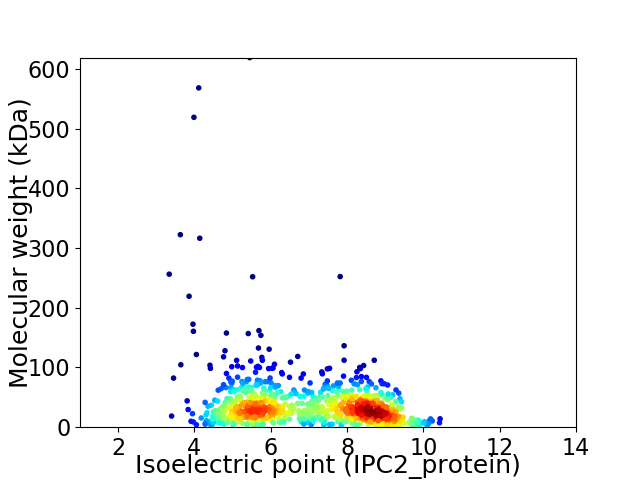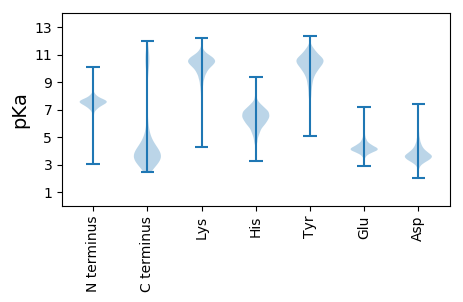
Chlamydiales bacterium SCGC AB-751-O23
Taxonomy: cellular organisms; Bacteria; PVC group; Chlamydiae; Chlamydiia; Chlamydiales; unclassified Chalmydiales
Average proteome isoelectric point is 6.97
Get precalculated fractions of proteins

Virtual 2D-PAGE plot for 876 proteins (isoelectric point calculated using IPC2_protein)
Get csv file with sequences according to given criteria:
* You can choose from 21 different methods for calculating isoelectric point
Summary statistics related to proteome-wise predictions



Protein with the lowest isoelectric point:
>tr|A0A212KPT4|A0A212KPT4_9CHLA Uncharacterized protein OS=Chlamydiales bacterium SCGC AB-751-O23 OX=1871322 GN=AB751O23_AJ_00140 PE=4 SV=1
MM1 pKa = 7.39EE2 pKa = 5.71HH3 pKa = 6.95LSDD6 pKa = 3.95YY7 pKa = 10.36LTIEE11 pKa = 3.92ALIEE15 pKa = 4.0KK16 pKa = 10.22EE17 pKa = 3.89KK18 pKa = 10.98FQDD21 pKa = 4.0NFQLCNYY28 pKa = 9.73AIQQVQNVVNVGNDD42 pKa = 3.07NFDD45 pKa = 3.62EE46 pKa = 5.0NEE48 pKa = 4.18IQNKK52 pKa = 9.64AYY54 pKa = 10.76NILDD58 pKa = 4.82GILHH62 pKa = 6.64DD63 pKa = 4.39RR64 pKa = 11.84DD65 pKa = 3.55FAEE68 pKa = 4.78EE69 pKa = 3.83FAEE72 pKa = 4.42SEE74 pKa = 4.65GSADD78 pKa = 3.6YY79 pKa = 11.17QNSSEE84 pKa = 4.22GNN86 pKa = 3.34
MM1 pKa = 7.39EE2 pKa = 5.71HH3 pKa = 6.95LSDD6 pKa = 3.95YY7 pKa = 10.36LTIEE11 pKa = 3.92ALIEE15 pKa = 4.0KK16 pKa = 10.22EE17 pKa = 3.89KK18 pKa = 10.98FQDD21 pKa = 4.0NFQLCNYY28 pKa = 9.73AIQQVQNVVNVGNDD42 pKa = 3.07NFDD45 pKa = 3.62EE46 pKa = 5.0NEE48 pKa = 4.18IQNKK52 pKa = 9.64AYY54 pKa = 10.76NILDD58 pKa = 4.82GILHH62 pKa = 6.64DD63 pKa = 4.39RR64 pKa = 11.84DD65 pKa = 3.55FAEE68 pKa = 4.78EE69 pKa = 3.83FAEE72 pKa = 4.42SEE74 pKa = 4.65GSADD78 pKa = 3.6YY79 pKa = 11.17QNSSEE84 pKa = 4.22GNN86 pKa = 3.34
Molecular weight: 9.89 kDa
Isoelectric point according different methods:
Protein with the highest isoelectric point:
>tr|A0A212KPG2|A0A212KPG2_9CHLA Elongation factor G OS=Chlamydiales bacterium SCGC AB-751-O23 OX=1871322 GN=fusA PE=3 SV=1
MM1 pKa = 7.63VDD3 pKa = 3.56LAKK6 pKa = 10.88VNSSGSLIRR15 pKa = 11.84EE16 pKa = 3.89SWEE19 pKa = 3.61LMRR22 pKa = 11.84NLHH25 pKa = 5.25SVRR28 pKa = 11.84GRR30 pKa = 11.84RR31 pKa = 11.84FQSFRR36 pKa = 11.84YY37 pKa = 8.91LVCPMNALALVAAGLVGRR55 pKa = 11.84ILGKK59 pKa = 10.05MILSDD64 pKa = 3.47KK65 pKa = 10.88LYY67 pKa = 9.58VQIFAFTVFLTLGLGTFSISRR88 pKa = 11.84IFQSRR93 pKa = 11.84IEE95 pKa = 4.01TLKK98 pKa = 10.8RR99 pKa = 11.84SLHH102 pKa = 6.24GGDD105 pKa = 3.5KK106 pKa = 10.9
MM1 pKa = 7.63VDD3 pKa = 3.56LAKK6 pKa = 10.88VNSSGSLIRR15 pKa = 11.84EE16 pKa = 3.89SWEE19 pKa = 3.61LMRR22 pKa = 11.84NLHH25 pKa = 5.25SVRR28 pKa = 11.84GRR30 pKa = 11.84RR31 pKa = 11.84FQSFRR36 pKa = 11.84YY37 pKa = 8.91LVCPMNALALVAAGLVGRR55 pKa = 11.84ILGKK59 pKa = 10.05MILSDD64 pKa = 3.47KK65 pKa = 10.88LYY67 pKa = 9.58VQIFAFTVFLTLGLGTFSISRR88 pKa = 11.84IFQSRR93 pKa = 11.84IEE95 pKa = 4.01TLKK98 pKa = 10.8RR99 pKa = 11.84SLHH102 pKa = 6.24GGDD105 pKa = 3.5KK106 pKa = 10.9
Molecular weight: 11.92 kDa
Isoelectric point according different methods:
Peptides (in silico digests for buttom-up proteomics)
Below you can find in silico digests of the whole proteome with Trypsin, Chymotrypsin, Trypsin+LysC, LysN, ArgC proteases suitable for different mass spec machines.| Try ESI |
 |
|---|
| ChTry ESI |
 |
|---|
| ArgC ESI |
 |
|---|
| LysN ESI |
 |
|---|
| TryLysC ESI |
 |
|---|
| Try MALDI |
 |
|---|
| ChTry MALDI |
 |
|---|
| ArgC MALDI |
 |
|---|
| LysN MALDI |
 |
|---|
| TryLysC MALDI |
 |
|---|
| Try LTQ |
 |
|---|
| ChTry LTQ |
 |
|---|
| ArgC LTQ |
 |
|---|
| LysN LTQ |
 |
|---|
| TryLysC LTQ |
 |
|---|
| Try MSlow |
 |
|---|
| ChTry MSlow |
 |
|---|
| ArgC MSlow |
 |
|---|
| LysN MSlow |
 |
|---|
| TryLysC MSlow |
 |
|---|
| Try MShigh |
 |
|---|
| ChTry MShigh |
 |
|---|
| ArgC MShigh |
 |
|---|
| LysN MShigh |
 |
|---|
| TryLysC MShigh |
 |
|---|
General Statistics
Number of major isoforms |
Number of additional isoforms |
Number of all proteins |
Number of amino acids |
Min. Seq. Length |
Max. Seq. Length |
Avg. Seq. Length |
Avg. Mol. Weight |
|---|---|---|---|---|---|---|---|
0 |
306603 |
30 |
5523 |
350.0 |
39.42 |
Amino acid frequency
Ala |
Cys |
Asp |
Glu |
Phe |
Gly |
His |
Ile |
Lys |
Leu |
|---|---|---|---|---|---|---|---|---|---|
6.165 ± 0.08 | 1.047 ± 0.041 |
5.243 ± 0.123 | 7.597 ± 0.128 |
5.453 ± 0.088 | 5.895 ± 0.128 |
1.825 ± 0.049 | 6.763 ± 0.083 |
8.391 ± 0.169 | 11.395 ± 0.128 |
Met |
Asn |
Gln |
Pro |
Arg |
Ser |
Thr |
Val |
Trp |
Tyr |
|---|---|---|---|---|---|---|---|---|---|
1.906 ± 0.046 | 4.852 ± 0.07 |
3.499 ± 0.076 | 3.599 ± 0.076 |
3.696 ± 0.066 | 8.301 ± 0.086 |
4.955 ± 0.149 | 5.531 ± 0.072 |
0.805 ± 0.027 | 3.083 ± 0.059 |
Most of the basic statistics you can see at this page can be downloaded from this CSV file
Proteome-pI is available under Creative Commons Attribution-NoDerivs license, for more details see here
| Reference: Kozlowski LP. Proteome-pI 2.0: Proteome Isoelectric Point Database Update. Nucleic Acids Res. 2021, doi: 10.1093/nar/gkab944 | Contact: Lukasz P. Kozlowski |
